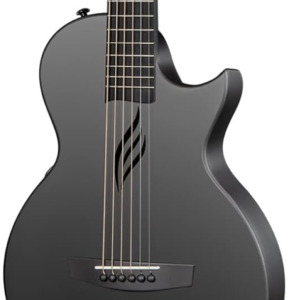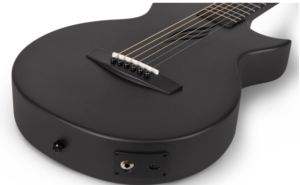Guitar tapping, also known as two-handed tapping or touch-style, is a technique primarily used on the electric guitar, although it can be adapted to acoustic guitar and other stringed instruments. It involves using both hands to fret and tap the strings on the fretboard, producing notes and chords.
Guitar Tapping History
 Guitar tapping, a technique synonymous with virtuosity and innovation, emerged in the late 1960s and early 1970s, although its roots trace back further. Experimental guitarists like Jimi Hendrix and Frank Zappa began exploring unconventional methods of producing sound on the instrument, including tapping the strings with their fingers or picks.
Guitar tapping, a technique synonymous with virtuosity and innovation, emerged in the late 1960s and early 1970s, although its roots trace back further. Experimental guitarists like Jimi Hendrix and Frank Zappa began exploring unconventional methods of producing sound on the instrument, including tapping the strings with their fingers or picks.
However, it was Eddie Van Halen who brought tapping into the mainstream with his groundbreaking solo “Eruption” on Van Halen’s 1978 debut album.
Van Halen’s lightning-fast tapping passages, combined with his innovative use of effects and amplification, captivated audiences and inspired countless guitarists to explore the possibilities of this technique.
Throughout the 1980s, tapping became synonymous with the burgeoning shred guitar movement, with players like Steve Vai, Joe Satriani, and Yngwie Malmsteen pushing the boundaries of speed and technicality.
Tapping techniques evolved to encompass not only single-note runs but also complex arpeggios, harmonies, and chord progressions. The technique continued to evolve into the 21st century, with players like Tosin Abasi of Animals as Leaders incorporating tapping into progressive metal and Djent styles, demonstrating that guitar tapping remains a dynamic and relevant technique in contemporary music.
Also Read:
Guitar Expressions Used by Guitarists
Ibanez RGT1270PB Guitar Review
10 Best Flanger Guitar Pedals for 2024
Enya NOVA Go SP1 Carbon Fiber Acoustic Electric Guitar
Mechanics of Tapping
 In tapping, the guitarist uses the picking hand (usually the right hand for right-handed players) to tap the strings against the fretboard, producing notes of varying pitches. Meanwhile, the fretting hand (usually the left hand) holds down other notes on the fretboard to create chords, melodies, or harmonies. This allows for rapid and intricate passages that might be difficult or impossible to achieve with conventional picking techniques alone.
In tapping, the guitarist uses the picking hand (usually the right hand for right-handed players) to tap the strings against the fretboard, producing notes of varying pitches. Meanwhile, the fretting hand (usually the left hand) holds down other notes on the fretboard to create chords, melodies, or harmonies. This allows for rapid and intricate passages that might be difficult or impossible to achieve with conventional picking techniques alone.
Performing tapping on the guitar requires coordination between both hands and a solid understanding of the fretboard. To begin, assume a comfortable playing position with the guitar supported properly. Typically, the picking hand (usually the right hand for right-handed players) is used to tap the strings, while the fretting hand (usually the left hand) is responsible for holding down other notes on the fretboard. Start by selecting a string and a fret to tap on; many players start with the high E string and the 12th fret for ease of access. Use the tip of your tapping finger (often the index or middle finger) to strike the string firmly against the fret, producing a clear note. Keep the tapping motion controlled and precise to ensure clean and articulate sound.
Next, coordinate the tapping motion with fretting notes on the fretboard using your other hand. While tapping, use your fretting hand to hold down notes on the fretboard to create melodies, chords, or arpeggios. Experiment with different fingerings and patterns to explore the full range of possibilities offered by tapping.
Practice synchronization between both hands to ensure that the tapped notes align rhythmically and harmonically with the fretted notes. Start slowly and gradually increase speed as you become more comfortable with the technique. Remember to maintain a relaxed posture and hand position to minimize tension and facilitate fluid movement.
How to Use Guitar Tapping
Tapping can be employed in various ways, including:
- Single-note tapping: Producing individual notes by tapping one finger of the picking hand onto the fretboard.
- Two-handed tapping: Simultaneously tapping with both hands to create chords, arpeggios, or melodies. This often involves tapping with both hands in a synchronized manner, allowing for complex and rapid sequences of notes.
- Tapping arpeggios: Using tapping to play arpeggios (broken chords) by tapping each note of the chord separately.
- Harmonics: Tapping can also be used to produce harmonics by tapping lightly on certain points of the string, creating bell-like tones.
Single Note Tapping
 Single note tapping is a technique in which a guitarist uses one hand, typically the picking hand, to tap individual notes on the fretboard while the other hand may be used to mute strings or provide support. This technique allows for rapid execution of melodic lines and intricate phrases, often with a fluid and legato-like quality.
Single note tapping is a technique in which a guitarist uses one hand, typically the picking hand, to tap individual notes on the fretboard while the other hand may be used to mute strings or provide support. This technique allows for rapid execution of melodic lines and intricate phrases, often with a fluid and legato-like quality.
Single note tapping is commonly utilized in solos and improvisations across various musical genres, including rock, metal, jazz, and fusion. It offers guitarists the ability to achieve fast and expressive passages that may be challenging to execute with conventional picking techniques alone.
To perform single note tapping, begin by selecting a string and fret on the fretboard where you want to start. With your picking hand, typically the index or middle finger, lightly tap the string against the fretboard to produce a clear note.
Ensure that your tapping finger strikes the string with enough force to sound the note but not too forcefully to avoid causing unwanted fret buzz. Meanwhile, your fretting hand can either be used to mute unwanted string noise or provide additional support by lightly resting on the strings behind the tapped note. Experiment with different fretting-hand positions and tapping finger placements to find the most comfortable and efficient technique for you.
Two Handed Tapping
Two-handed tapping, also known as two-hand tapping or touch-style tapping, is an advanced guitar technique where both hands are used to tap the strings on the fretboard to produce notes, chords, or arpeggios. Popularized by guitar virtuosos like Eddie Van Halen, Stanley Jordan, and Jennifer Batten, two-handed tapping offers a wide range of expressive possibilities and can create intricate and complex musical passages.
Unlike single-note tapping, which typically involves tapping with the picking hand while the fretting hand holds down other notes, two-handed tapping utilizes both hands simultaneously to create harmonically rich and rhythmically dynamic phrases.
To perform two-handed tapping, start by fretting a chord or a note with your fretting hand while simultaneously tapping other notes or chords with your picking hand. The tapping hand can be used to play melodies, arpeggios, or even percussive effects, while the fretting hand can provide additional support or mute unwanted string noise.
Coordination between both hands is crucial, and practicing slowly and gradually increasing speed and complexity is key to mastering this technique.
Tapping arpegios
 Tapping arpeggios is an advanced guitar technique that combines the principles of arpeggio playing with tapping. Arpeggios are broken chords where the notes of a chord are played individually in succession rather than simultaneously.
Tapping arpeggios is an advanced guitar technique that combines the principles of arpeggio playing with tapping. Arpeggios are broken chords where the notes of a chord are played individually in succession rather than simultaneously.
Tapping arpeggios involve using both hands to tap out the individual notes of an arpeggio on the fretboard, allowing for a fluid and seamless execution of complex chord progressions. This technique is particularly popular among rock, metal, and fusion guitarists who seek to add depth and virtuosity to their playing.
To perform tapping arpeggios, the guitarist typically begins by fretting a chord shape with the fretting hand while simultaneously tapping out the individual notes of the arpeggio with the picking hand.
The tapping hand usually executes the higher notes of the arpeggio while the fretting hand provides the lower notes. By synchronizing the movements of both hands, the guitarist can create cascading and harmonically rich arpeggio sequences that cascade effortlessly across the fretboard.
Tapping in the Classical Guitar
Conclusion
Tapping adds a unique sound and versatility to a guitarist’s repertoire, allowing for the execution of rapid-fire runs, complex chord progressions, and impressive solos. It requires precision, coordination, and practice to master effectively.
